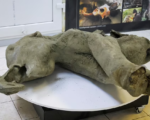In a remarkable discovery that has captivated the scientific community, a 37,000-year-old saber-toothed kitten has been found preserved in the Siberian permafrost, offering an extraordinary look into the life of an ancient predator. The nearly flawless remains, including the head, forelimbs, and upper body, were uncovered near the Badyarikha River, located just north of the Arctic Circle, in 2020. This astonishing find belongs to Homotherium latidens, a species of saber-toothed cat that roamed during the late Pleistocene era. The frozen remains provide an exceptional opportunity to study this extinct species and gain insights into its physical characteristics and lifestyle.
Radiocarbon dating and dental analysis performed by researchers suggest the kitten was only about three weeks old when it perished. The baby incisors found in its jaw provided a key clue to its young age, helping scientists piece together the timeline of its life and death. It is believed that the kitten’s life was abruptly cut short, likely by a sudden environmental event, after which its body became frozen in the permafrost, preserving it in almost perfect condition for millennia.
The discovery is significant not only for its rarity but also for the level of detail it provides about the anatomy of these ancient predators. The preserved body of the kitten, still covered in soft brown fur, has revealed intricate details that fossilized skeletons could never show. The intact whiskers on its lips, well-preserved footpads, and sharp claws offer researchers a rare glimpse into the soft tissue structure of Homotherium latidens, helping to fill gaps in knowledge about the physical features of saber-toothed cats that have long been elusive.
This find offers unprecedented opportunities for paleontologists to understand more about the behavior, environment, and life cycle of saber-toothed cats. By studying the preserved kitten, scientists can gain a deeper understanding of how these apex predators interacted with their environment and perhaps even what led to their extinction. As climate change continues to impact permafrost regions, this discovery highlights both the fragility and the potential for future findings in these rapidly changing environments.












